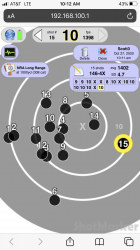Almost certainly not a bearing problem. The old "M" type, although looking a little agricultural is a good solid scale with few faults.
The round glass hard bearings are unlikely to wear even after a lot of use - and if they do, just slacken the retaining bolts and rotate each bearing a quarter of a turn and re-tighten. You then have a pristine new bearing surface that will last for another 30 years.
Two things I would do, would be to scrub across the beam notches with a soft brass wire brush and buy a basic set of grain checkweights. Both RCBS and Lyman do a set for $30-$40
It the scale repeats reliably and you have checkweights you can't go wrong.
If your 6br load is 29.6 grains, just place 29.6gn checkweights in the scale pan and zero you scale to that, every load will be the same. A scale doesn't need numbers to be accurate.
This is not a new idea - here's a Pacific with no numbers at all.

And a Redding:

The round glass hard bearings are unlikely to wear even after a lot of use - and if they do, just slacken the retaining bolts and rotate each bearing a quarter of a turn and re-tighten. You then have a pristine new bearing surface that will last for another 30 years.
Two things I would do, would be to scrub across the beam notches with a soft brass wire brush and buy a basic set of grain checkweights. Both RCBS and Lyman do a set for $30-$40
It the scale repeats reliably and you have checkweights you can't go wrong.
If your 6br load is 29.6 grains, just place 29.6gn checkweights in the scale pan and zero you scale to that, every load will be the same. A scale doesn't need numbers to be accurate.
This is not a new idea - here's a Pacific with no numbers at all.

And a Redding:













